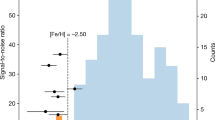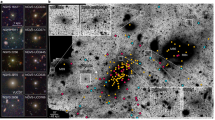Abstract
It is now generally believed that galaxies were built up through gravitational amplification of primordial fluctuations and the subsequent merging of smaller precursor structures. The stars of the structures that assembled to form the Milky Way should make up much or all of its bulge and halo, in which case one hopes to find ‘fossil’ evidence for those precursor structures in the present distribution of halo stars. Confirmation that this process is continuing came with the discovery of the Saggittarius dwarf galaxy1, which is being disrupted by the Milky Way, but direct evidence that this process provided the bulk of the Milky Way's population of old stars has hitherto been lacking. Here we show that about ten per cent of the metal-poor stars in the halo of the Milky Way, outside the radius of the Sun's orbit, come from a single coherent structure that was disrupted during or soon after the Galaxy's formation. This object had a highly inclined orbit about the Milky Way at a maximum distance of ∼16 kpc, and it probably resembled the Fornax and Sagittarius dwarf spheroidal galaxies.
This is a preview of subscription content, access via your institution
Access options
Subscribe to this journal
Receive 51 print issues and online access
$199.00 per year
only $3.90 per issue
Buy this article
- Purchase on Springer Link
- Instant access to full article PDF
Prices may be subject to local taxes which are calculated during checkout


Similar content being viewed by others
References
Ibata,R., Gilmore,G. & Irwin,M. J. A dwarf satellite galaxy in Sagittarius. Nature 370, 194–196 ( 1994).
Eggen,O. J., Lynden-Bell,D. & Sandage, A. R. Evidence from the motions of old stars that the Galaxy collapsed. Astrophys. J. 136, 748– 766 (1962).
Searle,L. & Zinn,R. Compositions of halo clusters and the formation of the galactic halo. Astrophys. J. 225, 357–379 (1978).
Gott,J. R. Recent theories of galaxy formation. Annu. Rev. Astron. Astrophys. 15, 235–266 ( 1977).
Larson,R. B. Models for the formation of elliptical galaxies. Mon. Not. R. Astron. Soc. 173, 671–699 ( 1975).
White,S. D. M. & Frenk,C. S. Galaxy formation through hierarchical clustering. Astrophys. J. 379, 52– 79 (1991).
Helmi,A. & White,S. D. M. Building up the stellar halo of the Galaxy. Mon. Not. R. Astron. Soc. 307, 495–517 (1999).
Johnston,K. V., Hernquist,L. & Bolte, M. Fossil signatures of ancient accretion events in the Halo. Astrophys. J. 465, 278– 287 (1996).
Beers,T. C. & Sommer-Larsen,J. Kinematics of metal-poor stars in the Galaxy. Astrophys. J. Suppl. Ser. 96, 175–221 (1995).
Chiba,M. & Yoshii,Y. Early evolution of the Galactic halo revealed from Hipparcos observations of metal-poor stars. Astron. J. 115, 168–192 ( 1998).
The Hipparcos and Tycho Catalogues (SP-1200, European Space Agency, ESA Publications Division, ESTEC, Noordwijk, The Netherlands, 1997).
Roeser,S. & Bastian,U. A new star catalogue of SAO type. Astron. Astrophys. (suppl.) 74, 449– 451 (1988).
Anthony-Twarog,B. J. & Twarog,B. A. Reddening estimation for halo red giants using uvby photometry. Astron. J. 107, 1577–1590 (1994).
Beers,T. C., Preston,G. W., Shectman,S. A. & Kage,J. A. Estimation of stellar metal abundance. I—Calibration of the Ca II K index. Astron. J. 100, 849– 883 (1990).
Norris,J., Bessell,M. S. & Pickles, A. J. Population studies. I. The Bidelman-MacConnell “weak-metal” stars. Astrophys. J. Suppl. Ser. 58, 463 –492 (1985).
Layden,A. C. The metallicities and kinematics of RR Lyrae variables 1: New observations of local stars. Astron. J. 108, 1016– 1041 (1994).
Sommer-Larsen,J., Beers,T. C., Flynn,C., Willhelm,R. & Christensen, P. R. A dynamical and kinematical model of the Galactic stellar halo and possible implications for Galaxy formation scenarios. Astrophys. J. 481, 775–781 (1997).
Bergbusch,P. A. & VandenBerg,D. A. Oxygen-enhanced models for globular cluster stars. II. Isochrones and luminosity functions. Astrophys. J. Suppl. Ser. 18, 163– 220 (1992).
Mateo,M. Dwarf galaxies of the Local Group. Annu. Rev. Astron. Astrophys. 36, 435–506 ( 1998).
Lynden-Bell,D. & Lynden-Bell,R. M. Ghostly streams from the formation of the Galaxy's halo. Mon. Not. R. Astron. Soc. 275, 429–442 ( 1995).
Acknowledgements
A.H. thanks the Max-Planck-Institut für Astrophysik for hospitality during her visits. We made use of the Simbad database (maintained by Centre de Données astronomiques de Strasbourg) and of the HIPPARCOS online facility at the European Space Research and Technology Centre (ESTEC) of the European Space Agency (ESA).
Author information
Authors and Affiliations
Corresponding author
Rights and permissions
About this article
Cite this article
Helmi, A., White, S., de Zeeuw, P. et al. Debris streams in the solar neighbourhood as relicts from the formation of the Milky Way. Nature 402, 53–55 (1999). https://doi.org/10.1038/46980
Received:
Accepted:
Issue Date:
DOI: https://doi.org/10.1038/46980
This article is cited by
-
Modelling the chemical evolution of the Milky Way
The Astronomy and Astrophysics Review (2021)
-
The mass of our Milky Way
Science China Physics, Mechanics & Astronomy (2020)
-
The merger that led to the formation of the Milky Way’s inner stellar halo and thick disk
Nature (2018)
-
Two chemically similar stellar overdensities on opposite sides of the plane of the Galactic disk
Nature (2018)
-
Motions in Sculptor in three dimensions
Nature Astronomy (2018)
Comments
By submitting a comment you agree to abide by our Terms and Community Guidelines. If you find something abusive or that does not comply with our terms or guidelines please flag it as inappropriate.



